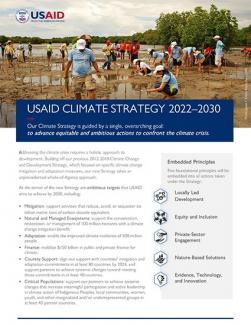Our Climate Strategy is guided by a single, overarching goal: to advance equitable and ambitious actions to confront the climate crisis.
Addressing the climate crisis requires a holistic approach to development. Building off our previous 2012–2018 Climate Change and Development Strategy, which focused on specific climate change mitigation and adaptation measures, our new Strategy takes an unprecedented whole-of-Agency approach.
At the center of the new Strategy are ambitious targets that USAID aims to achieve by 2030, including:
- Mitigation: support activities that reduce, avoid, or sequester six billion metric tons of carbon dioxide equivalent.
- Natural and Managed Ecosystems: support the conservation, restoration, or management of 100 million hectares with a climate change mitigation benefit.
- Adaptation: enable the improved climate resilience of 500 million people.
- Finance: mobilize $150 billion in public and private finance for climate.
- Country Support: align our support with countries’ mitigation and adaptation commitments in at least 80 countries by 2024, and support partners to achieve systemic changes toward meeting those commitments in at least 40 countries.
- Critical Populations: support our partners to achieve systemic changes that increase meaningful participation and active leadership in climate action of Indigenous Peoples, local communities, women, youth, and other marginalized and/or underrepresented groups in at least 40 partner countries.
Five foundational principles will be embedded into all actions taken under the Strategy:
- Locally Led Development
- Equity and Inclusion
- Private Sector Engagement
- Nature-Based Solutions
- Evidence, Technology, and Innovation
Responding to the climate crisis represents an economic, technological, ecological, and socio-political opportunity for countries to transition into societies with greater equality, well-being, and sustained prosperity for all.
Our efforts to achieve will be organized around two main Strategic Objectives:
- Targeted Direct Action. We recognize the need to prioritize and confront the most urgent demands of the climate crisis. We will carefully target climate change mitigation and adaptation efforts to the highest priority communities and locations—those with the most urgent needs or most immediate opportunities—to maximize our impact.
- Systems Change. We acknowledge that fully addressing the climate crisis requires long-term, transformative changes that affect every aspect of society and will be neither easy nor quick. USAID will take a systems approach to these larger transformations—such as transforming food systems to be more resilient, less wasteful and less environmentally destructive, or transitioning economic systems to be less carbon-intensive—in ways that are comprehensive, equitable, and locally led.
Our Strategic Objectives are supported by a Special Objective to Do Our Part. The Climate Strategy outlines how USAID will transform our own workforce, operations, and policies to substantially reduce carbon emissions, adapt to the climate crisis, and further climate justice—and support and expect our implementing partners to do the same.
Together with our partners and allies around the world, we must do all we can to advance equitable and ambitious actions to confront the climate crisis. Our future depends on it.

